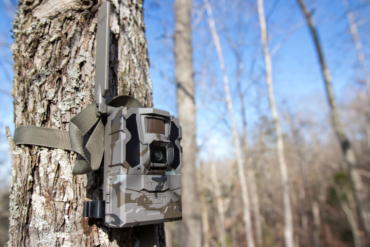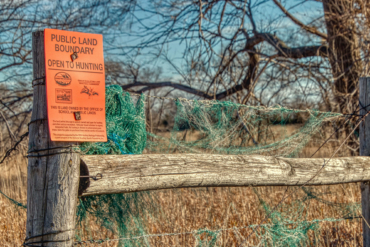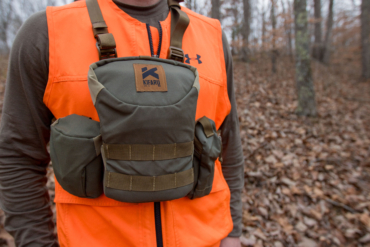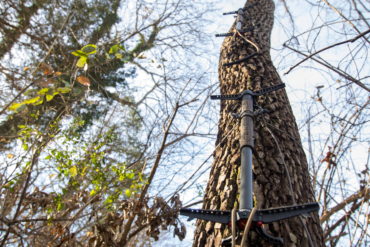Glassing is the name of the game in Western hunting, but it’s not easy. We’re going to help you shorten the learning curve.
Birds of prey are some of the most effective hunters on the planet, and a great deal of that success is due to their eyes. Eagles in particular can see clearly eight times farther than us humans. Their eyesight allows them to stay up high and survey the country beneath them for any hint of a meal.
Essentially, eagle eyes are built-in binoculars, and the way they survey the world offers a huge takeaway for Western hunters.
Of course, we are a far stretch from an eagle in terms of eyesight, but we can absolutely use the same hunting tactic as them by way of glassing with the aid of optics. Glassing will allow us to stay back from afar and survey the country in front of us for “any hint of a meal.”
In short: By efficiently using binoculars and spotting scopes, you’ll stay on the nonintrusive side of things instead of traipsing around willy-nilly and bumping the very animals you’re hunting. Whether it’s notating active travel corridors for a possible ambush setup or bedding an animal down and planning a stalk to their whereabouts, glassing offers a gateway to success.
There are definitely some proven tricks of the trade. Here’s my take on the matter.
How to Glass for Big Game
For context: Glassing, to some, is likely not a familiar term. But for hunters, glassing refers to looking through binoculars or spotting scopes in search of wild game. Though most people know the word glass as a noun, hunters use it quite literally as a verb that translates into looking for animals through “glass.”
Colloquially, hunters will “glass something up” or spend time “glassing” a hillside, in order to better understand the whereabouts of the game they’re after. It’s simply the art of sitting down, pulling out your binos or setting up your spotting scope, and taking the time to truly survey a landscape at a micro advantage.
Good Glass/Tripod/Head Combo

In order to really take your glassing up a notch, you’ll need a few key items. First, buy the best optics that you can afford. The better the glass, the longer you’ll be able to stay behind it.
Buy once, cry once, and you’ll experience less eye fatigue and headaches on the mountain. And these are literal things to worry about.
Next, mounting those optics on a tripod will up your game-spotting abilities tenfold. Looking through still and stabilized optics will allow you to spot movement much better than when freehanding.
And when you do spot an animal, you’ll be able to lock those binoculars in place, so you never lose their location. Stability also combats motion sickness and eye fatigue when glassing for long periods of time.
Lastly, the cherry on top is attaching a fluid pan head to that tripod. Most tripods come with a tripod head to get you started. Stepping it up and swapping it out for something like a Sirui VA-5 will blow your mind, though.
Literally, it’s a game-changing addition. This now allows you to not only have the stability of glassing from a tripod, but also to do so in fluid waves. Cheaper heads on the market tend to be sticky and don’t offer the overall fluidity that others do.
Use the Sun to Your Glassing Advantage

Put the sun at your back in the morning and in front of you in the afternoon/evening. This is a great rule of thumb when it comes to figuring out where to glass.
Having the sun at your back in the morning will illuminate the country in front of you. These are generally the faces that animals are going to be feeding on at breakfast time. Wildlife like deer and elk will pop in the sunlight as well.
When the sun is in front of you in the afternoon/evening, it means you’ll be looking into shaded country, which is where animals will be bedded. And once evening time comes, they’ll get up for their evening feeding routine.
So, focusing on these areas will both give the possibility of spotting something bedded during the day, but you’ll also be ready for when critters start getting up before sundown. Yes, it can be annoying when the sun is in front of you shining through your glass, but I promise you it works.
Rules are made to be broken, but this is a great starting point.
Glass for Things Out of Place

Notice the elk in the center of the frame.
The trick to spotting animals through your optics is really looking for things that are out of place. The landscape before you has a certain flow to it. Keep your eyes out for things that break that flow. Here are a few examples:
- Horizontal lines: Not many things in the mountains are perfectly horizontal, except an animal’s back, of course. Always pay mind to these. The line might just move all of a sudden.
- Colors: Getting in tune with the color of the animal you’re looking for is huge, especially when glassing thicker areas. The yellowish body of an elk, the white rump of a mule deer, or the black hide of a bear are examples.
- Texture: Whether it’s a velvet antler, hard-horned antler, or hide, these are all textures that are different from the rest of the landscape. The more you glass, the more you’ll start recognizing them.
In the end, we are not looking for whole animals, but for pieces of them.
Move If You Need To, But Wait It Out First
Glassing is definitely a patience game. You need to be able to sit down for extended periods of time staring into every nook and cranny.
Every time I sit down at a new glassing point, I say, “Show me your secrets.” This takes time, and you need to give the country a chance to work.
While patience is no doubt important, you also need to know when to get up to move locations. There are a few variables at play here, like how the country lays out and how much time you have. If I’m on a long ridge, for example, I might move every hour if I’m not seeing anything.
If I’ve got time on my side, though, maybe I’ll glass a certain area for a morning and an evening. If nada, I’ll move somewhere else the next day.
Let your glass do a lot of the walking for you, but recognize when an area isn’t producing.
Slow Down … A Lot

Along with giving an area a chance to work and not moving too soon, you can’t glass too fast. This is a big mistake I’ve witnessed time and time again. Panning too quickly through an area will leave a whole lot of stones unturned and doesn’t really give you the chance to spot that ear flick or tail wag.
I like to do this systematically and break the country up into sections. Say there are four fingers coming off the main parallel ridge right toward you.
I’ll glass each one of those fingers one at a time, giving myself a small break in between. Through each one of those sections, I’ll slowly grid search with my optics. And if the hill is dense with vegetation, that slow waltz grid search will turn to a crawl.
I’ll even put down the glass and grid with my eyes view by view when I’m really looking for a needle in a haystack. It helps me slow down behind the glass thinking of the landscape like this. If I don’t, I’ll tend to rush a bit, due to the overwhelming amount of country in front of me.
Glass Early, Glass Late
The biggest mistake I’ve seen folks make is either being late or leaving early. If you’re arriving at your glassing spot an hour after daylight, you’ve already missed quite a bit. And if you’re leaving your glassing spot an hour before dark, you’re also missing a lot.
These are critical times for animal movement, and you won’t see what you’ve missed. Even if you spot something at last light and don’t have time to do anything about it, you’ll have a starting point for the next day. Bring your charged headlamp and get comfortable hiking in the dark.
Eyes on the Prize

Being an effective and efficient hunter is all about taking in your surroundings and gathering little bits of intel as we go. We are watchers. And when the time is right, like any good predator, we make our move.
Glassing is one of the best ways to accomplish this.
There is no better intel than watching animals be animals. From their natural habits throughout the day to the very food that they eat, it’s all money in the bank for a hunter.
We may never get to eagle status, but we can sure learn from their predominant hunting tactic. Keep your eyes on the prize and, most importantly, behind the glass.







